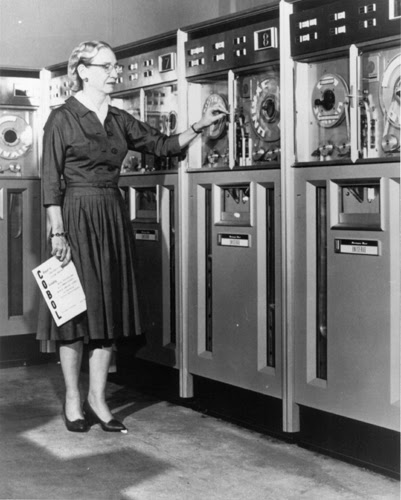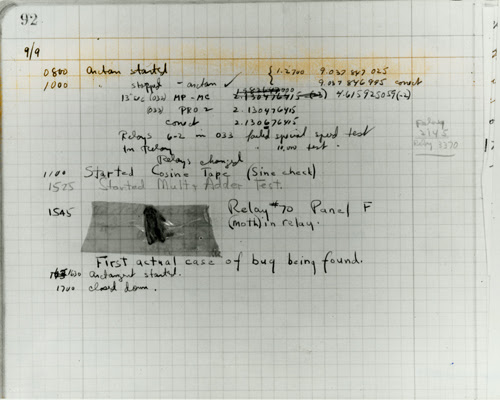Celebrating Grace Hopper and the origins of debugging
Have you ever wondered what it was like to code on the first computer, the Harvard Mark I? Or, as it was referred to in the 1940s, the “computing engine”?
It might shock you to learn that computer code was originally written by hand and recorded in physical notebooks. Thankfully, this manual practice was quashed in the early 1950s by Grace Hopper, the computer scientist and female programmer who invented the very first compiler.
Every year, Bugsnag commemorates Hopper on September 9th, the anniversary of the first computer bug she recorded, and affectionately refers to the occasion as “Bug Day”. It is also known as Tester’s Day in the QA and testing communities. That ill-fated moth represents the first time programmers were forced to stop and focus on a bug disrupting their work.
Today, that challenge continues to exist and begs the age-old software question: should we be fixing bugs or building new features? The ability to answer this one question is a game changer for engineers, who recognize the tremendous value of measuring software and application stability. In turn, it’s exciting to recognize how many organizations are now following suit and adopting stability as a KPI.
As an innovator, Grace Hopper was fully committed to improving what computers can do for humans. She would be proud to know that her fellow engineers want to look at the health of their applications and receive actionable insights to enable constant improvements.
Hopper’s Legacy: Compilers and programming languages
Hopper is famous for saying, “The most dangerous phrase in the language is, ‘We’ve always done it this way.’”
This belief speaks to her inspiration for inventing the compiler. For starters, Hopper found the reliance on handwritten code to be a source of frustration and failure, especially since her male colleagues’ penmanship left something to be desired. Numbers and letters were often confused or misinterpreted, which led to errors in programming code into the Mark I. (Imagine how hard debugging would have been!)

In addition, Hopper recognized that there’s no reason to separate code from machines. At the time, those working in the field didn’t believe it would be possible to “speak English” with computers, insisting that symbols were necessary. Hopper’s design for a compiler proved her colleagues wrong and demonstrated how high-level programming languages could be translated into binary languages that computers would understand.
It took three years for her idea to be accepted and for the first compiler to be built. Looking back on the experience, Hopper’s humor came through in her deadpan delivery: “Over these years, I’ve had a lot to do with computers. I’ve driven a large number of people at least partially nuts. After all, insisting on talking to computers in plain English is a totally ridiculous idea and you couldn’t do that. Except it worked.”
Not only did her compiler help computers evolve, but it also opened the door to the development of other computer languages. Hopper herself wrote a new language called FLOW-MATIC, which later was extended to create COBOL.
Overcoming gender challenges: a manual for change
Remarkably, Hopper’s list of accomplishments doesn’t end there—not even close. While she’s widely recognized for being part of the team that found the first computer “bug” (literally, a moth stuck in the relay contacts of the Harvard Mark II), Hopper also wrote the first computer programming manual.

This “first” may have had more to do with prejudice than inspiration. It’s rumored that Howard Aiken, the designer behind the Mark I computer, was resistant to a woman joining his team. That sentiment led him to assign Hopper the task of documenting how to work with the Mark I computer, a thankless exercise that he likely believed would help lead to her removal.
However, the 500-page manual she produced not only proved her mettle but also convinced Aiken to change his tune. Soon after, Hopper was selected over all the men on the team as Aiken’s primary programmer and top deputy, a position she maintained for many years.
Promoting women and minorities in STEM
As a female technology trailblazer, Hopper remains an inspiration and role model for generations of women and minorities who seek parity in the workplace—in representation, opportunity, and pay.
Bugsnag is committed to honoring Hopper’s legacy and to empowering women and minorities in STEM. This year, we are making a donation to Women Who Code to sponsor scholarships for women to attend coding camps. In addition, Bugsnag is partnering with a local Bay Area meetup called “Advancing Women in Tech” to hear members’ stories around how Hopper’s famous quotes apply to moments in their tech journey.
Speaking of quotes, Hopper believed in taking risks and, without a doubt, would encourage today’s women and minorities to take the leap and work in STEM. One of her seafaring analogies addresses the need for continuous tides of change and serves as inspiration for us all: “A ship in port is safe, but that is not what ships are for. Sail out to sea and do new things.”